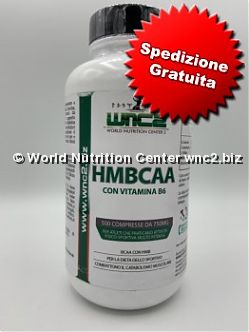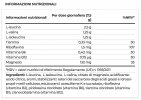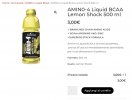Il danno muscolare indotto dall'esercizio fisico è ridotto nei maschi allenati con resistenza dagli aminoacidi a catena ramificata: uno studio randomizzato, in doppio cieco, controllato con placebo
FONTE: https://www.tandfonline.com/doi/full/10.1186/1550-2783-9-20
Pubblicato: 01/04/2022
Premessa
È ben documentato che il danno muscolare indotto dall’esercizio fisico (EIMD) diminuisce la funzione muscolare e causa dolore e disagio. È stato dimostrato che l’integrazione di aminoacidi a catena ramificata (BCAA) aumenta la sintesi proteica e diminuisce la disgregazione delle proteine muscolari, tuttavia, gli effetti dei BCAA sul recupero da allenamenti di resistenza dannosi non sono chiari. Pertanto, lo scopo di questo studio era di esaminare gli effetti di un'integrazione di BCAA sui marcatori di danno muscolare indotti attraverso un esercizio dannoso specifico per lo sport in volontari allenati.
Metodi
Dodici maschi (età media ± SD, 23 ± 2 anni; statura, 178,3 ± 3,6 cm e massa corporea, 79,6 ± 8,4 kg) sono stati assegnati in modo casuale a un gruppo con integratore (n = 6) o placebo (n = 6). L'esercizio dannoso consisteva in 100 salti consecutivi. Come marcatori di danno muscolare sono stati misurati la creatina chinasi (CK), la massima contrazione volontaria (MVC), il dolore muscolare (DOMS), il salto verticale (VJ), la circonferenza della coscia (TC) e la circonferenza del polpaccio (CC). Tutte le variabili sono state misurate immediatamente prima dell'esercizio dannoso e a 24, 48, 72 e 96 ore dopo l'esercizio.
Risultati
Per tutte le variabili è stato osservato un effetto temporale significativo. Sono stati riscontrati effetti di gruppo significativi che hanno mostrato una riduzione dell'efflusso di CK e del dolore muscolare nel gruppo BCAA rispetto al placebo (P<0,05). Inoltre, il recupero di MVC è stato maggiore nel gruppo BCAA (P<0,05). VJ, TC e CC non erano diversi tra i gruppi.
Il presente studio ha dimostrato che i BCAA somministrati prima e dopo un esercizio di resistenza dannoso riducono gli indici di danno muscolare e accelerano il recupero nei maschi allenati di resistenza. Sembra probabile che i BCAA forniscano una maggiore biodisponibilità del substrato per migliorare la sintesi proteica e quindi l’entità del danno muscolare secondario associato ad un intenso esercizio di resistenza. Numero di registrazione della sperimentazione clinica: NCT01529281.
I MIEI BCAA: (Clicca sull'immagine per andare alla pagina del prodotto.)




FONTE: https://www.tandfonline.com/doi/full/10.1186/1550-2783-9-20
Pubblicato: 01/04/2022
Premessa
È ben documentato che il danno muscolare indotto dall’esercizio fisico (EIMD) diminuisce la funzione muscolare e causa dolore e disagio. È stato dimostrato che l’integrazione di aminoacidi a catena ramificata (BCAA) aumenta la sintesi proteica e diminuisce la disgregazione delle proteine muscolari, tuttavia, gli effetti dei BCAA sul recupero da allenamenti di resistenza dannosi non sono chiari. Pertanto, lo scopo di questo studio era di esaminare gli effetti di un'integrazione di BCAA sui marcatori di danno muscolare indotti attraverso un esercizio dannoso specifico per lo sport in volontari allenati.
Metodi
Dodici maschi (età media ± SD, 23 ± 2 anni; statura, 178,3 ± 3,6 cm e massa corporea, 79,6 ± 8,4 kg) sono stati assegnati in modo casuale a un gruppo con integratore (n = 6) o placebo (n = 6). L'esercizio dannoso consisteva in 100 salti consecutivi. Come marcatori di danno muscolare sono stati misurati la creatina chinasi (CK), la massima contrazione volontaria (MVC), il dolore muscolare (DOMS), il salto verticale (VJ), la circonferenza della coscia (TC) e la circonferenza del polpaccio (CC). Tutte le variabili sono state misurate immediatamente prima dell'esercizio dannoso e a 24, 48, 72 e 96 ore dopo l'esercizio.
Risultati
Per tutte le variabili è stato osservato un effetto temporale significativo. Sono stati riscontrati effetti di gruppo significativi che hanno mostrato una riduzione dell'efflusso di CK e del dolore muscolare nel gruppo BCAA rispetto al placebo (P<0,05). Inoltre, il recupero di MVC è stato maggiore nel gruppo BCAA (P<0,05). VJ, TC e CC non erano diversi tra i gruppi.
Il presente studio ha dimostrato che i BCAA somministrati prima e dopo un esercizio di resistenza dannoso riducono gli indici di danno muscolare e accelerano il recupero nei maschi allenati di resistenza. Sembra probabile che i BCAA forniscano una maggiore biodisponibilità del substrato per migliorare la sintesi proteica e quindi l’entità del danno muscolare secondario associato ad un intenso esercizio di resistenza. Numero di registrazione della sperimentazione clinica: NCT01529281.
I MIEI BCAA: (Clicca sull'immagine per andare alla pagina del prodotto.)











